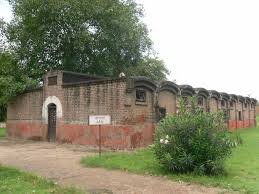Delhi’s Prison Crisis: Why a New Jail is the Need of the Hour
Delhi’s largest prison complex, Tihar Jail, is currently housing more than 14,000 inmates—nearly triple its sanctioned capacity of around 5,200. This alarming overpopulation has not only raised human rights concerns but also severely strained infrastructure, prison staff, and rehabilitation efforts.
To address this, the Delhi government is moving forward with a long-term decongestion plan that includes relocating Tihar Jail to a new location on the outskirts of Delhi, constructing new, modern high-security prisons, and collaborating with multiple land-owning agencies to acquire land for additional facilities. This multi-pronged approach has been confirmed by high-ranking government officials and budget allocations in the 2025-26 state plan.
Narela: Delhi’s First High-Security Jail in the Making
The most concrete step so far is a new high-security prison being built in Narela, modeled after the Cellular Jail in the Andaman and Nicobar Islands. It is being designed to house 250–300 high-risk inmates, such as organized crime convicts and habitual offenders.
Key Features of the Narela High-Security Jail:
- Fully automated locking systems
- 8 high-tech watch towers
- Video conferencing rooms for court proceedings
- Medical and administrative blocks
- Solitary confinement spaces
- Surveillance & control rooms
The Delhi Public Works Department (PWD) has already floated a construction tender, and the facility is expected to be operational within 21 months. The project is being funded jointly by ₹100 crore from the Central Government and ₹40 crore from the Delhi Government.
Tihar Jail Relocation: What’s the Plan?
In its 2025-26 Budget, the Delhi Government earmarked ₹10 crore for a feasibility survey and expert consultation on relocating Tihar Jail. The prison, located in West Delhi, has become heavily congested, not only due to population pressures but also due to the surrounding urban sprawl, which limits future expansion.
A senior official said:
“The long-term idea is to decentralize and modernize prison facilities while also addressing humanitarian concerns.”
Land Talks Underway for Future Prisons
According to reports from Hindustan Times, the Delhi Government has initiated meetings with the Land and Development Office, Delhi Development Authority (DDA), and the Revenue Department. These discussions are focused on identifying large land parcels in and around Delhi for future prison facilities. These new prisons will align with modern correctional goals: safety, rehabilitation, and minimal human rights violations.
“Our aim is to transform Delhi’s prison infrastructure in line with global correctional standards,” said a senior Delhi Home Department official.
How Will This Move Impact Inmates and Prison Administration?
Positive Implications:
- Better living conditions for inmates, especially undertrials
- Reduced inmate-to-warden ratios, improving supervision and safety
- Improved access to legal and medical support
- Increased focus on rehabilitation, including skill development programs
Delhi’s larger strategy also includes upgrading vocational training for inmates and implementing tech-enabled reforms such as e-courts and remote hearings to reduce prisoner movement costs and risks.
A Progressive Step Toward Prison Reform
The move to overhaul Delhi’s prison infrastructure marks a significant shift in how urban prison systems in India are planned. Tihar’s overcrowding has long been a symbol of the justice system’s limitations. With the construction of modern facilities like the Narela jail and relocation efforts for Tihar, Delhi is setting the stage for a more humane, efficient, and secure correctional framework.
While timelines and execution will be crucial to watch, the intent and planning indicate a major step toward systemic reform and long-overdue infrastructure upgrades.
FAQs: Delhi’s Prison Expansion Plan
Q1. Why is the Delhi government planning to relocate Tihar Jail?
Tihar Jail is operating at nearly three times its capacity. The relocation is part of a broader effort to reduce overcrowding, improve inmate conditions, and enhance prison security.
Q2. Where is the new prison being built?
A new high-security prison is under construction in Narela, designed to house high-risk inmates. It is expected to be operational by 2026.
Q3. How is the project being funded?
The Central Government is contributing ₹100 crore, and the Delhi Government is contributing ₹40 crore toward the Narela facility.
Q4. What are the features of the new Narela jail?
It will include automated security systems, watch towers, a medical block, solitary confinement areas, and tech-enabled court access.
Q5. Will relocating Tihar Jail solve overcrowding?
Relocating Tihar and building new jails will help reduce the pressure on Delhi’s prison system. However, experts say long-term success will also depend on judicial reforms, bail process improvements, and better rehabilitation programs.
Q6. What is the current status of land acquisition for more jails?
Meetings are ongoing with various agencies, including DDA and the Revenue Department, to identify and acquire land for future facilities.

